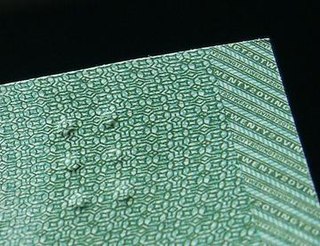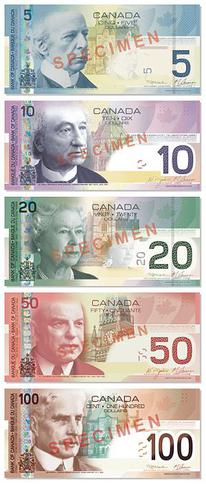Related Research Articles

Federal Reserve Notes, also United States banknotes, are the currently issued banknotes of the United States dollar. The United States Bureau of Engraving and Printing produces the notes under the authority of the Federal Reserve Act of 1913 and issues them to the Federal Reserve Banks at the discretion of the Board of Governors of the Federal Reserve System. The Reserve Banks then circulate the notes to their member banks, at which point they become liabilities of the Reserve Banks and obligations of the United States.

The United States five-dollar bill ($5) is a denomination of United States currency. The current $5 bill features a portrait of Abraham Lincoln, the 16th U.S. president (1861-1865), on the front and the Lincoln Memorial on the back. All $5 bills issued today are Federal Reserve Notes.
Large denominations of United States currency greater than $100 were circulated by the United States Treasury until 1969. Since then, U.S. dollar banknotes have been issued in seven denominations: $1, $2, $5, $10, $20, $50, and $100.

The United States one-dollar bill (US$1), sometimes referred to as a single, has been the lowest value denomination of United States paper currency since the discontinuation of U.S. fractional currency notes in 1876. An image of the first U.S. president (1789–1797), George Washington, based on the Athenaeum Portrait, a 1796 painting by Gilbert Stuart, is currently featured on the obverse, and the Great Seal of the United States is featured on the reverse. The one-dollar bill has the oldest overall design of all U.S. currency currently being produced. The obverse design of the dollar bill seen today debuted in 1963 when it was first issued as a Federal Reserve Note.
Coins of the Indian rupee (INR) were first minted in 1950. New coins have been produced annually since then and they make up a valuable aspect of the Indian currency system. Today, circulating coins exist in denominations of One Rupee, Two Rupees, Five Rupees, Ten Rupees and Twenty Rupees. All of these are produced by four mints located across India, in Kolkata, Mumbai, Hyderabad, Noida.

The Canadian currency tactile feature is a feature on the Canadian Journey and Frontier series of Canadian banknotes to aid people who are visually impaired to identify the notes. The feature indicates the banknote denomination in the upper left corner of the face side of the bill using a series of raised dots. It was suggested by Bruno Thériault, an administrator for the Canadian National Institute for the Blind, and designed by Susan Lederman, a professor of psychology at Queen's University.

Counterfeiting of the currency of the United States is widely attempted. According to the United States Department of Treasury, an estimated $70 million in counterfeit bills are in circulation, or approximately 1 note in counterfeits for every 10,000 in genuine currency, with an upper bound of $200 million counterfeit, or 1 counterfeit per 4,000 genuine notes. However, these numbers are based on annual seizure rates on counterfeiting, and the actual stock of counterfeit money is uncertain because some counterfeit notes successfully circulate for a few transactions.
The history of the United States dollar began with moves by the Founding Fathers of the United States of America to establish a national currency based on the Spanish silver dollar, which had been in use in the North American colonies of the Kingdom of Great Britain for over 100 years prior to the United States Declaration of Independence. The new Congress's Coinage Act of 1792 established the United States dollar as the country's standard unit of money, creating the United States Mint tasked with producing and circulating coinage. Initially defined under a bimetallic standard in terms of a fixed quantity of silver or gold, it formally adopted the gold standard in 1900, and finally eliminated all links to gold in 1971.

Hell money is a modernized form of joss paper printed to resemble legal tender bank notes. The notes are not an official form of recognized currency or legal tender as their sole intended purpose is to be offered as burnt offerings to the deceased as a solution to resolve their assumed monetary problems in the afterlife. This ritual has been practiced by modern Chinese and across East Asia since the late 19th century, and some Wicca-based faiths in recent years have adopted this practice. Early 20th century examples bore resemblance to minor commercial currency of the type issued by businesses across China until the mid-1940s.
Visual impairment, also known as vision impairment, is a medical definition primarily measured based on an individual's better eye visual acuity; in the absence of treatment such as correctable eyewear, assistive devices, and medical treatment– visual impairment may cause the individual difficulties with normal daily tasks including reading and walking. Low vision is a functional definition of visual impairment that is chronic, uncorrectable with treatment or correctable lenses, and impacts daily living. As such low vision can be used as a disability metric and varies based on an individual's experience, environmental demands, accommodations, and access to services. The American Academy of Ophthalmology defines visual impairment as the best-corrected visual acuity of less than 20/40 in the better eye, and the World Health Organization defines it as a presenting acuity of less than 6/12 in the better eye. The term blindness is used for complete or nearly complete vision loss. In addition to the various permanent conditions, fleeting temporary vision impairment, amaurosis fugax, may occur, and may indicate serious medical problems. The abbreviation VIP is sometimes used for Visually Impaired Person, Persons or People.
The pound was one of several issues of Japanese invasion money used during World War II. One pound was subdivided into 20 shillings. Consisting of only four denominations, the Oceanian pound was the shortest set issued. Only notes for £1, 10/–, 1/– and 1/2/– were issued.

Banknotes of the Canadian dollar are the banknotes or bills of Canada, denominated in Canadian dollars. Currently, they are issued in $5, $10, $20, $50, and $100 denominations. All current notes are issued by the Bank of Canada, which released its first series of notes in 1935. The Bank of Canada has contracted the Canadian Bank Note Company to produce the Canadian notes since then. The current series of polymer banknotes were introduced into circulation between November 2011 and November 2013. Banknotes issued in Canada can be viewed at the Bank of Canada Museum in Ottawa.

Canadian Journey is the sixth series of banknotes of the Canadian dollar designed and circulated by the Bank of Canada. It succeeded the 1986 Birds of Canada banknote series. The first banknote of the Canadian Journey series issued into circulation was the $10 bill on 17 January 2001, and the last to be issued was the $50 bill on 17 November 2004. The series was succeeded by the 2011 Frontier Series, the banknotes of which were first issued into circulation from 2011 to 2013.
The Sam Bernstein Law Firm, formerly known as The Law Offices of Sam Bernstein and The Law Offices of Samuel I. Bernstein, is an American law firm, located in Farmington Hills, Michigan. The firm specializes in personal injury. In 2008, its main office employed approximately 50 employees.

James Robertson was a United States district judge of the United States District Court for the District of Columbia from 1994 until his retirement in June 2010. Robertson also served on the Foreign Intelligence Surveillance Court from 2002 until December 2005, when he resigned from that court in protest against warrantless wiretapping.

Birds of Canada is the fifth series of banknotes of the Canadian dollar issued by the Bank of Canada and was first circulated in 1986 to replace the 1969 Scenes of Canada series. Each note features a bird indigenous to Canada in its design. The banknotes weigh 1 gram with dimensions of 152.40 by 69.85 millimetres. It was succeeded by the 2001 Canadian Journey series.

Banknotes of the euro, the common currency of the eurozone, have been in circulation since the first series was issued in 2002. They are issued by the national central banks of the Eurosystem or the European Central Bank. The euro was established in 1999, but "for the first three years it was an invisible currency, used for accounting purposes only, e.g. in electronic payments". In 2002, notes and coins began to circulate. The euro rapidly took over from the former national currencies and slowly expanded around the European Union.

The Philippine one thousand-peso note is a denomination of Philippine currency. It is the largest denomination in general circulation in the Philippines. It is currently the only Philippine peso denomination that has a polymer banknote version.

People with disabilities in Pakistan are seen differently than in most Western countries due to cultural and religious beliefs. The lack of accurate epidemiological evidence on disabilities, insufficient resources, weak health care facilities and worker shortages are major obstacles to meeting the needs of disabled Pakistanis.
Seeing AI is an artificial intelligence application developed by Microsoft for iOS. Seeing AI uses the device camera to identify people and objects, and then the app audibly describes those objects for people with visual impairment.
References
- ↑ Würdemann, Henry Vanderbilt; Black, Nelson Miles (1913). "Ophthalmology: Essays, Abstracts and Reviews". Milwaukee: American Medical Association press: 51.
{{cite journal}}: Cite journal requires|journal=(help) - ↑ "Keeping Track of Money". American Foundation for the Blind. Archived from the original on June 16, 2013. Retrieved June 17, 2013.
- ↑ "How blind people identify paper money". February 18, 2019. Retrieved December 23, 2019.
- ↑ "Government appeals currency redesign". USA Today . Associated Press. December 13, 2006. Retrieved March 26, 2010.
- ↑ CNNMoney.com (November 29, 2006). "Judge rules paper money unfair to blind" . Retrieved February 17, 2008.
{{cite web}}:|author=has generic name (help) - ↑ "Court Says Next Gen Currency Must Be Accessible to the Blind". Archived from the original on November 28, 2008. Retrieved June 12, 2015.
- ↑ "disablednyc.com". www.disablednyc.com. Retrieved May 19, 2021.
- ↑ "Progress Update: United States Accessible Currency Project for Blind and Visually Impaired Persons". VisionAware. January 12, 2015. Retrieved May 19, 2021.
- ↑ "Administrative Provisions : Department of the Treasury". Office of Management and Budget . Retrieved January 2, 2012– via National Archives.